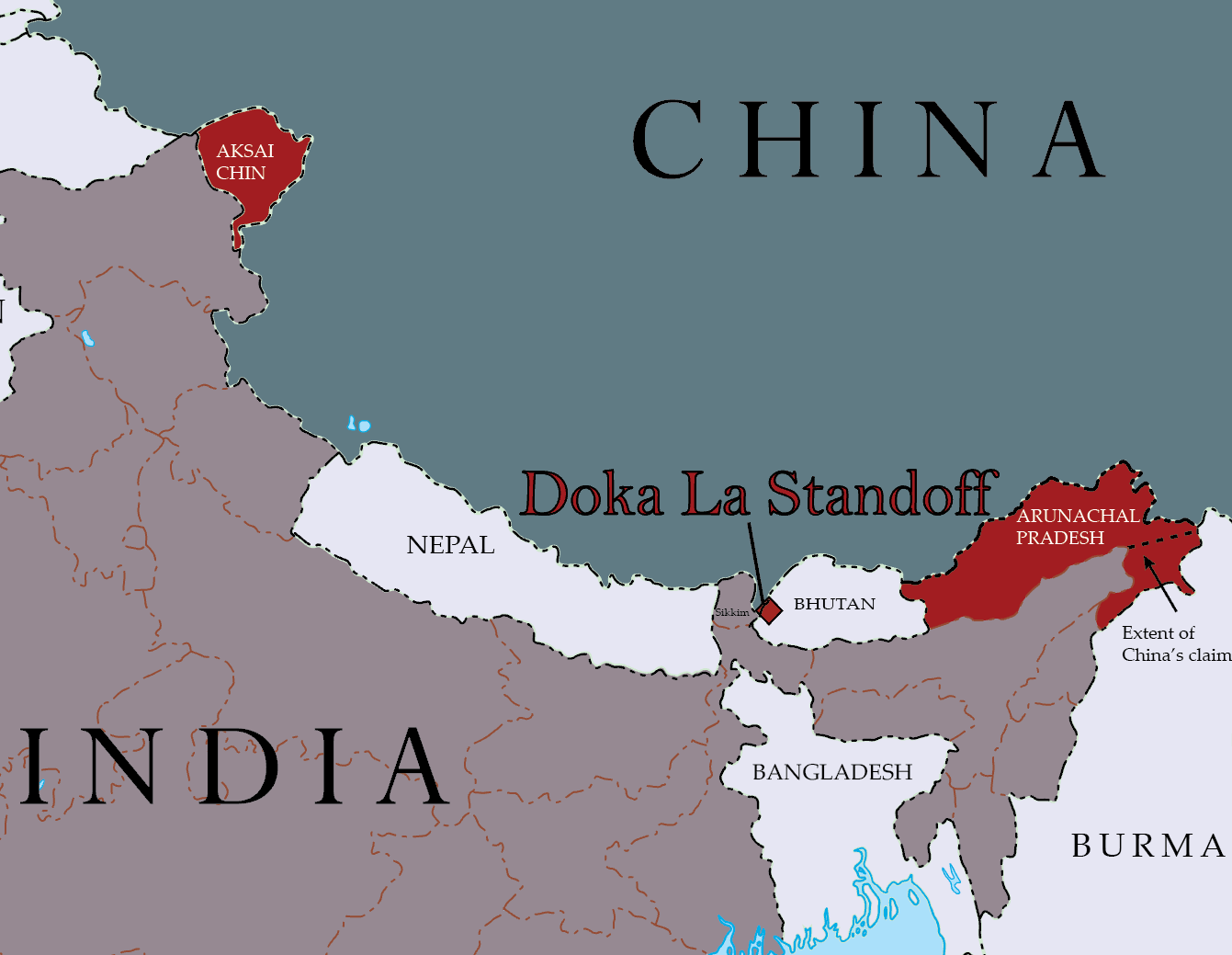India-China military standoff: placing a choke-hold on the “chicken’s neck”?
Written by: on
A military confrontation between India and China that flared up towards the end of June remains unresolved.
Caught in the middle is the tiny independent kingdom of Bhutan.
The crisis erupted in a small portion of territory whose control is in dispute between China and Bhutan. The area is known as Doklam. China claims that it is part of Yadong County of the Tibet Autonomous Region according to an 1890 Convention on Sikkim and Tibet which was formally signed between the then Qing government of China and the UK. The area is regarded by Bhutan as part of its territory.
When China began construction of a road in Doklam, Indian troops crossed over from neighbouring Sikkim and troops from the two countries jostled and pushed each other. According to reports, they remain in a situation of tense stand-off. India claimed that it was defending Bhutan, although no request for Indian involvement was issued by the Bhutanese government.
Strategic significance of the “chicken’s neck”
Doklam is one of three small areas in dispute between China and Bhutan. It is not far from the “chicken’s neck”, a small gap less than 30 kilometres wide in some places situated between Nepal and Bangla Desh through which India accesses its North-Eastern provinces. China also claims part of Arunachal Pradesh, currently held by India, to Bhutan’s east.
The state-owned Chinese Global Times was not shy in hinting at China’s potential to cause trouble for India.
“Though the statement of the Indian Ministry of External Affairs evaded the issue, Indian experts, scholars and the media openly pointed out the Indian army's real motive of this action: to prevent China's construction in the Doklam area and possible future military deployment, which could block the road from mainland India to the "chicken neck" of northeast India. Northeast Indian people don't identify closely with India, and there are several armed organizations striving for northeastern states' independence from India.
“This incursion reflects that India fears China can quickly separate mainland India from northeast India through military means, dividing India into two pieces. In this case, northeast India might take the opportunity to become independent.”
Both Global Times and People’s Daily have warned that India is inviting a repeat of the 1962 war between the two countries, a war provoked by India.
India a part of US containment of China
India is not blameless. Sikkim became India’s 22nd state in 1975 when Indian troops deposed its monarchy. Bhutan has so far maintained its independence although it has an agreement with India whereby that country “guides” its defence and foreign policy.
Under Narendra Modi’s Prime Ministership, India has developed closer ties with the US, Israel, Australia and Vietnam. Last September for instance, PM Modi announced a new line of credit of $500 million for Vietnam to facilitate deeper military cooperation. It has refused to endorse or support China’s One Belt, One Road initiative and has strongly opposed China’s actions in the South China Sea.
China’s latest road construction in disputed territory with Bhutan (it has been doing so on and off since 2005) occurred at the same time that Modi was hugging Donald Trump at the White House (June 26) and being feted by Benjamin Netanyahu in Tel Aviv (July 4). China is clearly displeased with Modi’s anti-China alliances.
Although Modi is confronting China politically, diplomatically and militarily, India has bought into the Beijing-based Asian Infrastructure Investment Bank (AIIB) and is its second-largest shareholder after China. China has made an initial commitment of $29.87 billion compared to India’s $8.37 billion. Sharing a capital partnership with China, India must carefully consider how far it should go in provoking China.
The world is a village, and even a fire in a tiny back lane can soon spread to nearby houses and the whole community.
India should take its troops back to Sikkim. It should withdraw any pressure on Bhutan to prevent it from establishing diplomatic relations with China and the Chinese should refrain from provocative gestures such as road building in disputed areas. Bhutan and China should continue talks which have been going on over the years to resolve border disputes peacefully and on the basis of mutual equality.
Print Version - new window Email article
-----
Go back
Independence from Imperialism
People's Rights & Liberties
Community and Environment
Marxism Today
International
Articles
| The US and Venezuela, 2025: moves to reassert the Monroe Doctrine |
| The struggle for mastery, and the uses and abuses of power: AI data-centres in outer space, part 2 |
| China winning the economic war with USA |
| Palestinian people's struggle not forgotten |
| Pegasus: US and Israel strengthen connections |
| Japan’s new PM drives tension in our region |
| Indian Maoists reject capitulation and surrender |
| Away with the Yankee presence in the waters of the Caribbean |
| Stop the militarisation of Space |
| The construction of a new Syria |
| US, Israel and Australia: the Indo-Pacific Strategy |
| Statement on the Massacres Committed by the Rapid Support Forces Militias in Bara and El-Fasher |
| US imperialism’s back yard blues |
| Venezuela: Resist Trump’s gangster tactics |
| DFLP to Hold Video Conference on Gaza |
| Adelaide rally in support of Palestinians calls for action not words by Australian government |
| Message from the Central Committee of the Communist Party of Burma on the 86th anniversary of its founding |
| US-Chinese rivalry in Micronesia |
| German comrades rally against Rheinmetall |
| Superpower rivalry and the Pacific Islands Forum |
-----

